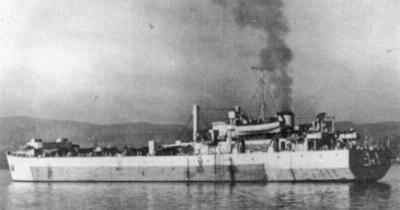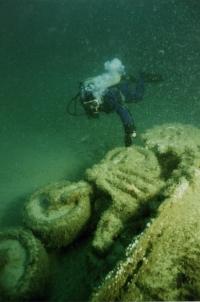|
CHARLIE By Tony Leone My landing ship, Coast Guard
LST 27, was in the middle of a watery hell. The day would soon claim
hundreds of lives as moored mines broke loose with the fury of the
storm. We rammed into a sunken wreck and were stuck; unable to move
in any direction! The bow lookout, Joe "Bitso" Coulson informed
the conning tower of our dire predicament. Our signalman contacted
an LST approaching our flank to inform them they should take our place
at once in the landing pattern. It was LST 523, carrying the 300th
Combat Engineers. I was
was split in two by a muffled
explosion. The bow and stern sections seemed to hang forever in the
air then landed amid curtains of bloody debris and broken bodies.
My body refused to move as I watched the stern settle slowly into
the English Channel, a naval officer caught in the rigging above.
He was a goner, I thought. The mountainous waves soon covered the
watery grave as survivors of the landing ship tried to stay afloat.
I saw crewman of LST 523 feverishly climbing aboard life rafts, assisting
others at the same time. There were men from the 300th clinging to
floating wreckage, arms locked with sailors who were badly injured.
Nightmare.
drop the balsa life rafts
overboard and to hand out Kapok life jackets. I saw it all and still
remained frozen in my tracks. I did not believe what I saw. The scene
was so unreal it defied description.
I was a horrified witness to all this and I could not move. Others did act however and I saw LSVPs and other small boats braving the storm to rescue hundreds of survivors. One LCVP was manned by a naval officer who was lifting an injured soldier aboard, assisted by a crewman. There was a gaping wound in the chest of the combat engineer. As the waves swept the craft away, I saw the officer in foul weather gear bend over the soldier, administering plasma. On board LST 523 at the time
of the explosion was Charlie " Buddy" Olive, corporal in
Company B, 3rd Platoon, 300th Combat Engineers Battalion. Buddy was
a lucky man because had he been below deck, he would have perished
with the others. That's what they
Editor's
Note: The last photo (above) is LST 523's current resting place. She
has become a popular diving site for people rediscovering the graveyard
of ships off Normandy. Here's what they say about her: She was a "large
ocean going vessel that was carrying around 20 Sherman Tanks when
she was sunk by a mine in 1944.
|
|
Visitors since
June 6, 2000 |


